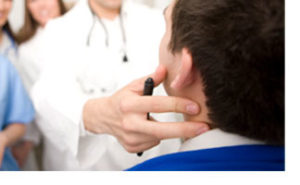 Oral cancers account for about two percent of all malignancies and 1.2 percent of cancer-associated deaths. If oral cancer is caught early, the five-year survival rate is 82.8 percent. Once the cancer metastasizes, that rate drops to 28 percent.
Oral cancers account for about two percent of all malignancies and 1.2 percent of cancer-associated deaths. If oral cancer is caught early, the five-year survival rate is 82.8 percent. Once the cancer metastasizes, that rate drops to 28 percent.
The American Dental Association recommends oral cancer screening as a standard procedure during routine dental exams. While only about a third of adults report being screened during recent dental exams, some people are even less likely to be screened.
A recent study led by researchers at Brigham and Women’s Hospital discovered that people’s race, ethnicity and socioeconomic status affect whether dentists routinely screen them for oral cancer. The study found that members of ethnic and racial minority groups were 53 to 73 percent less likely to report that a dentist had examined them for oral cancer over the previous two years. Within each minority group (non-Hispanic blacks, Asians, Mexican Americans and “other” Hispanics), being poor, less educated and uninsured placed an individual at the highest risk for not being screened.
“We have long known that disparities exist in the U.S. health care system,” said one of the authors, Regan W. Bergmark, MD, sinus and endoscopic skull base surgeon in the Brigham’s Division of Otolaryngology-Head and Neck Surgery. It is known, for example, that patients in racial or ethnic minority groups and those of low socioeconomic status present with more advanced cancers. These patients therefore have poorer odds for survival and lower quality of life.
“The question is, what is the mechanism and how do we fix it? What we found here is that opportunities to screen for oral cavity cancer in this population are being missed,” Dr. Bergmark added. “For example, even people who had seen a dentist in the last two years were less likely to report being screened for oral cancer if they were in a racial or ethnic minority group, or of lower socioeconomic status. Even smokers were less likely to be screened.”
Dr. Bergmark said it’s imperative for surgeons to interrupt the cycle of health care disparities and address the needs of vulnerable patient populations. The Brigham is tackling this issue, as well as others in health care access, through its Center for Surgery and Public Health (CSPH), where Dr. Bergmark serves as a faculty member. Established in 2005, the CSPH advances the science of surgical care delivery by studying effectiveness, quality, equity and value at the population level.
“When most people think about access to health care, they think about primary care,” Dr. Bergmark said. “However, disparities in care may be severe, and also poorly understood, in specialty areas like surgery. Surgery is a central and essential tool in the preservation of human life and improvement in quality of life, yet we have shown that Americans do not have equal access to high-quality surgical care.”
Researchers at the Brigham’s CSPH are working to improve quality of surgical care nationwide by studying ways to chip away at access barriers, such as patients’ insurance status, access to transportation, and language and cultural differences. They are also studying geographic barriers to care in rural and other underserved areas.
“Patients will have an issue accessing surgical care if the closest surgeon is a four-hour drive away,” Dr. Bergmark said. “We need to identify underserved communities and develop a structure that encourages and incentivizes surgeons to serve there.”
For oral cancer screenings, Dr. Bergmark and her colleagues concluded that the rate of oral cancer screening exams among minority high-risk populations could be improved by both educating patients to request the screening in dental offices and adequately training dental professionals on culturally sensitive communications.
“Our oral cancer screening study was a perfect example of how the Brigham and our CSPH are transforming health care delivery by focusing on ways to get people diagnosed and treated as early as possible,” Dr. Bergmark said. “Our multidisciplinary approach to care and our incredible depth of research and clinical expertise make the Brigham a truly exciting environment in which to address issues of health equity.”